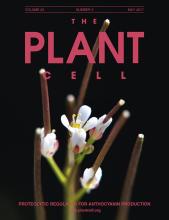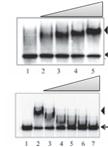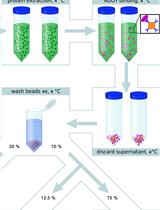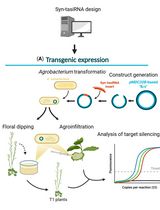- EN - English
- CN - 中文
Trimolecular Fluorescence Complementation (TriFC) Assay for Direct Visualization of RNA-Protein Interaction in planta
三分子荧光互补(TriFC)实验直接观察植物中RNA-蛋白质的相互作用
发布: 2017年10月20日第7卷第20期 DOI: 10.21769/BioProtoc.2579 浏览次数: 12744
评审: Tie LiuAlexandros AlexandratosHonghong Wu
Abstract
RNA-Protein interactions play important roles in various eukaryotic biological processes. Molecular imaging of subcellular localization of RNA/protein complexes in plants is critical for understanding these interactions. However, methods to image RNA-Protein interactions in living plants have not yet been developed until now. Recently, we have developed a trimolecular fluorescence complementation (TriFC) system for in vivo visualization of RNA-Protein interaction by transient expression in tobacco leaves. In this method, we combined conventional bimolecular fluorescence complementation (BiFC) system with MS2 system (phage MS2 coat protein [MCP] and its binding RNA sequence [MS2 sequence]) (Schonberger et al., 2012). Target RNA is tagged with 6xMS2 and MCP and RNA binding protein are fused with YFP fragments. DNA constructs encoding such fusion RNA and proteins are infiltrated into tobacco leaves with Agrobacterium suspensions. RNA-Protein interaction in vivo is observed by confocal microscope.
Keywords: Long non-coding RNA (长非编码RNA)Background
Recently, a variety of types of long-noncoding RNAs (lncRNAs) has been identified and shown to play important roles in transcriptional regulation and chromatin modification (St Laurent et al., 2015). So far, most of the molecular mechanisms for lncRNA-mediated functions are closely related with RNA-Protein interactions (St Laurent et al., 2015). Therefore, an experiment for RNA-Protein interaction is a key step in functional study of lncRNAs. In plants, molecular functions of lncRNAs are only beginning to be characterized, and the molecular basis of lncRNA-mediated gene regulation is still poorly understood. Though techniques for RNA visualization in plants have been well developed, visual assay for RNA-Protein interaction in plant is still poorly developed (Christensen et al., 2010). To develop the visual assay for RNA-Protein interaction in plants, we modified and combined MS2 system for RNA imaging technique with conventional BiFC system for protein-protein interaction (Schonberger et al., 2012) (Figure 1D). We generated binary Gateway vectors (pBA3130, 3132, 3134, and 3136) for transient BiFC assay (Seo et al., 2017) and got binary Gateway vectors (pBA-GW-6xMS2 and pBA-6xMS2-GW) for RNA tagging from Dr. Ulrich Z. Hammes (Schonberger et al., 2012). We tested and confirmed this TriFC assay was working well in plants with lncRNA, ELENA1, and MED19a protein (Seo et al., 2017). TriFC assay in plants will provide new insights in interaction between lncRNAs and proteins.
Materials and Reagents
- Pipette tips (Thermo Fisher Scientific, Fisher ScientificTM BasixTM Universal Tips)
- Fisherbrand sterile 100 x 15 mm polystyrene Petri dish (Fisher Scientific, catalog number: FB0875713 )
- 1 ml syringes (BD, catalog number: 302100 )
- 50 ml Falcon tubes (Corning, Falcon®, catalog number: 352070 )
- Agrobacterium tumefaciens (strain GV3101)
- Nicotiana benthamiana (N. benthamiana) plants; 2-4 weeks old (6-10 leaves stage)
- Gateway entry clones for RNA, RNA binding protein (RNA-BP), and MCP
- TriFC Gateway destination vectors (pBA3130, 3132, 3134, 3136, pBA-GW-MS2, and pBA-MS2-GW)
- LR clonase II (Thermo Fisher Scientific, InvitrogenTM, catalog number: 11791100 )
- LB medium powder (MP Biomedicals, catalog number: 113002082 )
- Spectinomycin (1,000x; 100 mg/ml) (Sigma-Aldrich, catalog number: S4014 )
- Gentamycin (1,000x; 50 mg/ml) (Sigma-Aldrich, catalog number: G1264 )
- Kanamycin (1,000x; 100 mg/ml) (Sigma-Aldrich, catalog number: K0200000 )
- Bacto agar (BD, BactoTM, catalog number: 214010 )
- Ethanol or DMSO
- MES (Sigma-Aldrich, catalog number: M8250 )
- Magnesium chloride (MgCl2) (Sigma-Aldrich, catalog number: M8266 )
- Acetosyringone (Sigma-Aldrich, catalog number: D134406 )
- LB media (see Recipes)
- LB agar media (see Recipes)
- 100 mM acetosyringone stock (see Recipes)
- LB-MES (pH 5.6) (see Recipes)
- Resuspension solution (see Recipes)
Equipment
- PIPETMAN ClassicTM Pipettes (Gilson, model: P1000, P100, P20, catalog number: F123602 , F123615 , F123600 )
- Centrifuge for 50 ml tubes (Beckman Coulter, model: Avanti® J-20XP )
- Spectrometer (Biochrom, model: Ultrospec 2100 pro )
- Confocal laser scanning microscope (ZEISS, model: LSM 780 )
- Autoclave (TOMY DIGITAL BIOLOGY, model: ES-215 )
- Laminar flow cabinet (NuAire, model: NU-440-400E )
- Incubator (MMM Medcenter Einrichtungen, model: INCUCELL 55 )
- Shaking incubator (Infors, model: Multitron Standard )
Software
- ZEN (Image analysis program for ZEISS confocal microscope)
Procedure
文章信息
版权信息
© 2017 The Authors; exclusive licensee Bio-protocol LLC.
如何引用
Seo, J. S. and Chua, N. (2017). Trimolecular Fluorescence Complementation (TriFC) Assay for Direct Visualization of RNA-Protein Interaction in planta. Bio-protocol 7(20): e2579. DOI: 10.21769/BioProtoc.2579.
分类
植物科学 > 植物分子生物学 > RNA > RNA-蛋白质相互作用
分子生物学 > RNA > RNA-蛋白质相互作用
您对这篇实验方法有问题吗?
在此处发布您的问题,我们将邀请本文作者来回答。同时,我们会将您的问题发布到Bio-protocol Exchange,以便寻求社区成员的帮助。
Share
Bluesky
X
Copy link














